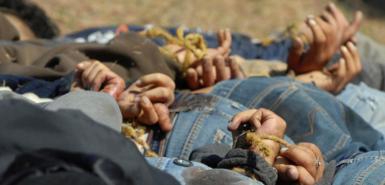According to Mexico’s Attorney General’s Office, conflict between organized criminal groups has resulted in the beheading of 1,303 people in five years, a grisly tactic becoming the hallmark of the war between the country’s cartels.
El Universal reported that decapitations steadily increased during President Felipe Calderon’s term in office: just 32 beheadings were registered in 2007, while 2011 registered 493 such deaths between January and November.
The count will likely be similarly high for 2012. Last May saw the discovery of 49 headless and dismembered bodies in Nuevo Leon state, attributed to the Zetas, who are closely associated with the tactic.
According to El Universal, the border states most affected by drug violence are also the ones that see the greatest number of victims beheaded. Chihuahua state registered 171 such killings during Calderon’s term, followed by Guerrero (149), Tamaulipas (119), Durango (115), and Sinaloa (89).
InSight Crime Analysis
Previously to 2006, decapitations — especially done en masse — was a relatively rare phenomenon in Mexico. One of the most prominent cases took place in September 2006, when the Familia Michoacana announced their existence by leaving five heads on a dance floor in Michoacan. The brutality of the tactic was meant to attract attention, terrorize the local population, and intimidate any rivals.
As the data recently released by the Attorney General’s Office shows, beheadings have only become more common since then. Decapitations are used to deliver threats to rival criminal groups or to government institutions (and even schools). 2012 has seen several mass beheadings. from Guadalaja (18 killed) to Nuevo Laredo (14 killed, with the heads placed in ice chests in several locations across the city).
This may be partly indicative of how crowded Mexico’s criminal market has become. With the large transnational organizations splintering and new generation groups emerging as the primary drivers of violence, the only way to assert themselves is by becoming more dependent on brutality and shock tactics. The state with the second-highest number of beheadings, Guerrero, is one of the areas most affected by these warring splinter groups, the remnants of the Beltran Leyva Organization. The high number of decapitations here looks like a symptom of that conflict.
The increase in beheadings — along with the mass dumping of bodies in public places — is a move away from the traditional practice of burying victims in mass, hidden graves. It also speaks to the need for criminal groups to appear ever more intimidating in these public displays of violence.
The rise in beheadings has also accompanied an overall rise in the number of massacres in Mexico. Crime analyst and National Autonomous University of Mexico (UNAM) professor Eduardo Guerrero told El Universal that during the first three years of Calderon’s term in office, Mexico registered an average of 10.3 massacres per month, while the second half of his term registered an average of 23 massacres per month.
There are other arguments for why decapitations have become more frequently seen. Secretary of Public Security Genaro Garcia Luna has said that Mexico’s criminal groups copied the execution style from Al Qaeda. Garcia Luna cited an incident attributed to the Zetas in December 2005, when the criminal group displayed the heads of four policemen in resort city Acapulco, as the “beginning” of Mexican groups’ adoption of “terrorist” tactics. Similarly to Al Qaeda, Mexico criminal organizations have also recorded and distributed videos of beheadings online.
Security analyst Samuel Gonzalez Ruiz has argued that the tactic was popularized after the Zetas received training from Guatemalan special forces squad the Kaibiles.
Archaeologist Ernesto Vargas told Time magazine that the strategy echoes methods used by the Mayans hundreds of years ago, stating, “The Mayans cut off the heads of prisoners as a symbol of complete domination over their enemies.”
Beheadings also played an important role in Aztec mythology, in which the practice was also applied to prisoners of war and was related to fertility rituals.

